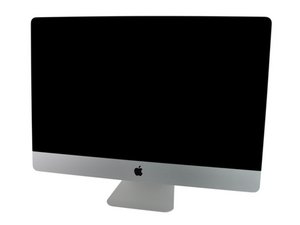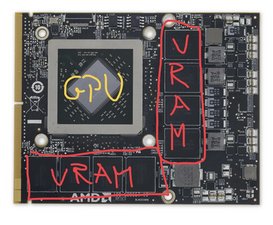Just like water, it will seek a lower elevation. Given how the iMac logic board is setup on its edge the Liquid Metal TIM will slowly drip down wetting the circuit board damaging it!
I’m sure you would like the system to last as such don’t use any Liquid Metal TIM on your systems that either have a vertical mounted logic board or a laptop which often is stored in a vertical configuration. Horizontal logic boards it makes sense and don’t let it sit in a vertical stand!
As for what to use the GPU it’s self uses the same TIM as your CPU any non conductive or capacitive TIM will do. We all often try to push the limits thinking the testers of things review makes out this TIM is better than the next. While that can be true in some cases, often times today the TIM’s argued about are so close in performance it really makes little difference. Think it this way are you racing your car on the Indi 500? There I can see how a 1/4 of a degree makes a difference.
OK, but what about the VRAM chips? Apple started off using pads and to save time they jumped to a gapping TIM, frankly it’s not as good as the more modern pad materials. For fit I often recommend using some cut up business cards to create a feeler gage to judge the thickness. For most boards 1.5mm is needed. Just make sure to use a slightly larger piece so the entire VRAM chip is covered.
So while we’ve focused on the physical aspects, you should also install a good thermal monitoring App like TG Pro so you can keep an eye on your thermals and if need be pump up the fans cooling.
Here’s an image of a MXM board marked up
The yellow needs thermal paste, the red needs the pads
crwdns2934105:0crwdne2934105:0
crwdns2934113:0crwdne2934113:0
crwdns2915270:0crwdne2915270:0
crwdns2889612:0crwdne2889612:0
1


 5
5  10
10  1
1 

crwdns2944067:06crwdne2944067:0
Personally, I think liquid metal is a little overkill for a GPU in an almost 15 year old computer. Thermal paste is also much safer than using liquid metal.
crwdns2934271:0crwdnd2934271:0 Junaayd Shaikh crwdne2934271:0
@junaaydshaikh i was thinking that since those iMac stock gpus had an overheating issue, using LMetal would be the best way to lower the heat.
In what way do u think that LMetal is overkill ?
crwdns2934271:0crwdnd2934271:0 genik crwdne2934271:0
@genik im sorry, i completely forgot that gpus were replaceable and on the mac board itself. i was subconsciously thinking he was going to use an egpu wired into the board.
crwdns2934271:0crwdnd2934271:0 Junaayd Shaikh crwdne2934271:0
@genik - Per your image the larger R56 block devices are inductors and the eight smaller SMD devices I believe are voltage regulators. Neither access the GPU heat sink block as such there is no thermal binding needed (no thermal paste or pads needed and you don’t want them covered otherwise the air flows will be interfered with.
crwdns2934271:0crwdnd2934271:0 DanJ crwdne2934271:0
All those were covered with thermal putty by Apple.,, but u say they shouldnt have been... right?
crwdns2934271:0crwdnd2934271:0 genik crwdne2934271:0
crwdns2934273:01crwdne2934273:0